De Hoop Nature Reserve
De Hoop Nature Reserve is a nature reserve in the Western Cape Province of South Africa.
| De Hoop Nature Reserve | |
|---|---|
African black oystercatchers at De Hoop | |
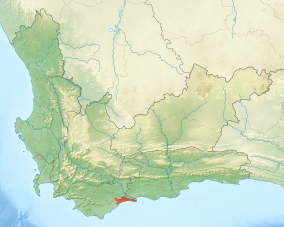 Location of De Hoop Nature Reserve | |
| Location | Western Cape, South Africa |
| Nearest city | Bredasdorp |
| Coordinates | 34°26′3″S 20°32′52″E |
| Area | 34,000 ha (84,000 acres) |
| Established | 1957 |
| Governing body | CapeNature |
| Website | De Hoop Nature Reserve |
| Official name | De Hoop Vlei |
| Designated | 12 March 1975 |
| Reference no. | 34[1] |
It lies three hours from Cape Town in the Overberg region, near Cape Agulhas, the southern tip of Africa. Approximately 340 square kilometres (130 sq mi) in area,[2] it is one of the largest natural areas managed by CapeNature.
De Hoop is one of the components of the "Cape Floral Region Protected Areas" World Heritage Site.
The De Hoop Marine Protected Area extends three nautical miles out to sea from the coastline of the nature reserve.[3]
Climate
De Hoop Nature Reserve's climate is Mediterranean, with warm summers and mild winters. The reserve gets 380 mm of rain annually. August is the wettest month. In summer, winds blow in from the east, west and southeast, whereas winter has westerly and southwesterly winds.[3]
Vegetation
The vegetation De Hoop Nature Reserve is part of the world's smallest and most threatened plant kingdom, known as the Cape Floral Kingdom. The reserve also contains one of the largest areas of the rare lowland fynbos.[3]
Animals
De Hoop is haven for both terrestrial and marine animals. Numerous species inhabit these habitats. The reserve has a total of 86 mammal species. These include the rare bontebok and Cape mountain zebra, eland, grey rhebok, chacma baboon, yellow mongoose and caracal. Leopard, although rare, are also found in the reserve.[3]
The waters within the De Hoop Reserve support good populations of marine mammals such as dolphins and seals. The bays of De Hoop are the breeding grounds for southern right whales. The marine protected area of the reserve has a total of 250 species of fish.[3]
Birds
De Hoop supports a large number of resident and migratory bird species. The reserve's total bird species count is 260. Several water birds breed in the reserve. The reserve is also home to the only remaining breeding colony of the rare Cape vulture.[3]
Missile Testing
The eastern part of the reserve is occasionally used by the Denel Overberg Test Range for missile testing. There is no danger to hikers as the reserve closes the area well before the testing date.[3]
Gallery
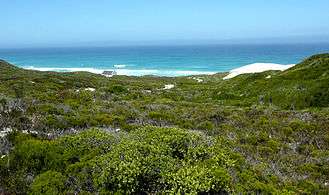 De Hoop Nature Reserve
De Hoop Nature Reserve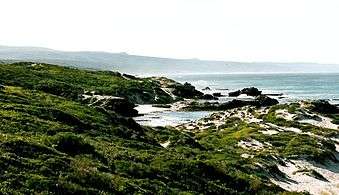 A beach in the De Hoop Nature Reserve
A beach in the De Hoop Nature Reserve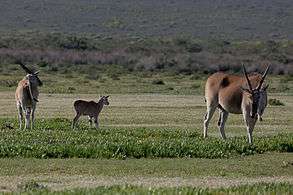 Common eland, with a calf
Common eland, with a calf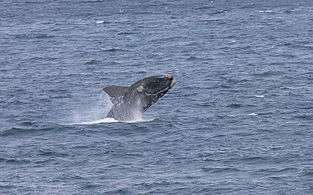 A southern right whale breaching at De Hoop Nature Reserve
A southern right whale breaching at De Hoop Nature Reserve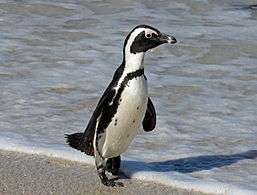 African penguin
African penguin Cape bulbul
Cape bulbul
See also
- CapeNature
- Protected areas of South Africa
References
- "De Hoop Vlei". Ramsar Sites Information Service. Retrieved 25 April 2018.
- "De Hoop Nature Reserve". CapeNature. Retrieved 16 September 2014.
- "De Hoop Nature Reserve". CapeNature. Archived from the original on 2 October 2013. Retrieved 30 September 2013.
External links
| Wikimedia Commons has media related to De Hoop nature reserve, South Africa. |

- De Hoop Nature Reserve